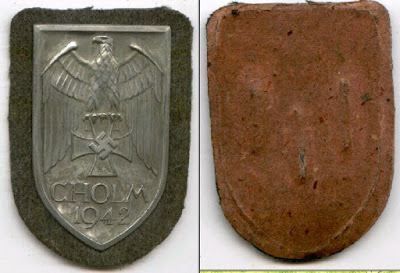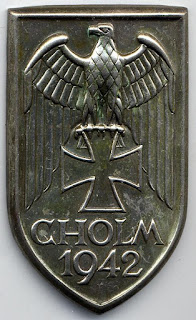As many readers of the Armourer will know, we
have been doing a series of articles
for beginners, in collecting German War medals of the Third Reich.
I now feel it is the right time to cover some of the rarer and elusive items that can be acquired
with research, patience and diligence.
The German armed forces with her allies, under
the direction of Adolf Hitler,
had invaded Russia in Operation Barbarrosa. Unfortunately for the troops involved, this was the road to
four years of bitter fighting and then for those
who survived, several more years of brutal Soviet captivity. In the early years however, it seemed that
Germany was unstoppable. The Russian armies were quickly surrounded and annihilated
in the first few months of the invasion.
It was only when winter came that the German armies were stopped. Ill prepared for this cold
season, it was the ideal time for the Russians
to launch their counter offensive. This they did in the first week of December 1941, when Marshall Zhukov
launched "Operation Typhoon" and with the combination of appalling bad weather and lack of
winter equipment, they pushed the
invading German army back from the gates of Moscow.
In the North of Russia, on the Southern Flank of
Army Group North, the German 16th
Army reeled under this hammer blow, conceding ground, but still hanging onto the two main routes
through the swamps, covering the area between
the lakes of Seeliger and Ilmen. These routes ran through the towns of "Cholm" and
"Demjansk". Here the German Army dug in and awaited adequate warm clothing and fresh supplies.
Hitler had given orders that there was to be
no retreat and as such, these garrisons or fortress towns were to be established.
In Cholm, (which is in the Kalinin region of
Russia, located on the Lovat River),
Battle Group Scherer was formed with approximately 5500 men, isolated, outnumbered, and surrounded.
These men managed to hold out for several
months (In total 105 days), and this small force withstood over 100 infantry attacks with 42 of these
being supported by tanks, by a superior
Russian force, which is more remarkable when you know that many of these troops were not combat units, rather supply or transport units like a Naval unit.
Russian force, which is more remarkable when you know that many of these troops were not combat units, rather supply or transport units like a Naval unit.
Finally in the Spring, the garrison was relieved,
but only about 1,200 of the
original 5500 survived intact. Throughout the ordeal, the besieged troops were supplied by air with some
of the wounded being flown out. During heavy
attack and in the absence of heavy weapons, this small pocket was supported by artillery fire 10 miles
away in the main German lines.
Following this epic battle, Major General Theodor Scherer was awarded a Knight's Cross and his men were given a battle shield.
Following this epic battle, Major General Theodor Scherer was awarded a Knight's Cross and his men were given a battle shield.
The Cholm shield was instituted on 1/7/42 and was
for any member of the armed
forces who served in a single, or all, military units between 21/1-5/5/42.
Entitlement was also open to those troups who
were killed or wounded in action
and for the airforce and navy personnel who assisted in evacuation of the said wounded.
This is the rarest official shield to be
instituted, as less than 5500 soldiers
would have been eligible and most of them would have perished in Russia.
Award documents were signed by General Major
Scherer who was the fortress Commander.
Bestowal for these awards ceased on 1/4/43, with the only exception being for the men who were MIA or POW`s.
Bestowal for these awards ceased on 1/4/43, with the only exception being for the men who were MIA or POW`s.
The shield design itself is very striking and
powerful looking and consists of
a shield shaped stamped metal, flat topped award which resembles a knight's shield in shape. The main
design is a wehrmacht eagle holding an Iron Cross
with a swastika and below this is the word "CHOLM" and the date "1942" under the word. There
are two main types of lettering the longer "M" and
the Shorter "M". So far, all shields that have been examined by us have been of pressed metal construction, either of magnetic metal or fine zinc. They appear to have a combination of the number of pins and also their positions ranging from 2 to 4 affixed on the back. This in turn passes through a backing cloth whose colour can range from basic army green being the most
common, to luftwaffe, then navy and panzer. There is speculation as to the two different types of backing shape, one type follows the design of the shield, whereas another is a long oval shape. One person has put forward the theory that the long oval shape types in steel were the first to be issued and the zinc ones were replacements. Personally, I discount this theory as we
have found combinations of both types on both backings.
the Shorter "M". So far, all shields that have been examined by us have been of pressed metal construction, either of magnetic metal or fine zinc. They appear to have a combination of the number of pins and also their positions ranging from 2 to 4 affixed on the back. This in turn passes through a backing cloth whose colour can range from basic army green being the most
common, to luftwaffe, then navy and panzer. There is speculation as to the two different types of backing shape, one type follows the design of the shield, whereas another is a long oval shape. One person has put forward the theory that the long oval shape types in steel were the first to be issued and the zinc ones were replacements. Personally, I discount this theory as we
have found combinations of both types on both backings.
With regards to copies, we have seen several
different types from solid metal
castings, to good quality stampings. These have all been in the wrong type of metal. Also there are major
differences between the styles of the eagle's
head on the originals to the reproductions.
With the re-institution of the 1957 awards, this award was sanctioned. The only design change is the omission of the swastika. The award was only worn on a ribbon bar and the shield itself was sold as a commemoration piece.
With the re-institution of the 1957 awards, this award was sanctioned. The only design change is the omission of the swastika. The award was only worn on a ribbon bar and the shield itself was sold as a commemoration piece.
Prices:
To date, you should expect to pay at least
£1450.00 for a good example of a
Cholm Shield on army green backing and add an extra £50.00 for luftwaffe and £150.00 for navy/panzer issue,
both steel or zinc.



